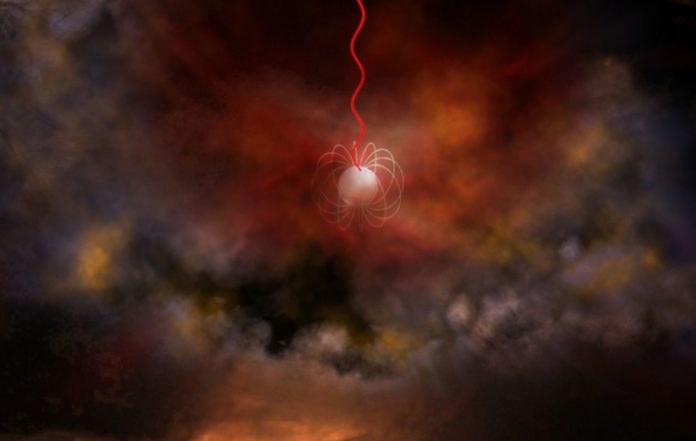Only the second example of a very active, repeated Fast Radio Burst (FRB) with a confined source of weaker but persistent radio emission between bursts has been discovered by astronomers.
After the finding, scientists are asking new questions about what these mystery particles are, and how they may be used to better understand intergalactic space. The object, initially spotted in 2019, was studied using the National Science Foundation’s Karl G. Jansky Very Large Array (VLA) and other telescopes.
The object, known as FRB 190520, was discovered by China’s FAST (Five-hundred-meter Aperture Spherical Radio Telescope). On May 20, 2019, the object burst, and data from that telescope was discovered in November of that year. Observations conducted with FAST revealed that, unlike many other FRBs, this one releases frequent, repetitive bursts of radio waves.
The object’s location was established by measurements with the VLA in 2020, which allowed visible-light studies with the Subaru telescope in Hawaii to demonstrate that it is in the outskirts of a dwarf galaxy roughly 3 billion light-years from Earth. Observations with the VLA also revealed that the object continuously emits weaker radio signals between bursts.
“These characteristics make this one look a lot like the very first FRB whose position was determined — also by the VLA — back in 2016,” remarked Caltech’s Casey Law. This discovery was a huge advance because it revealed for the first time the environment and distance of a FRB. However, the 2016 object, known as FRB 121102, was distinguished from all other known FRBs by its combination of repetitive bursts and continuous radio emission between bursts, which came from a compact location.
“Now we have two like this,” Law added, “and that brings up some important questions.” Law is a member of an international group of astronomers publishing their findings in Nature.
Differences between FRB 190520, FRB 121102, and all the others suggest two types of FRBs.
“Are those that repeat different from those that don’t? What about the persistent radio emission — is that common? ” Kshitij Aggarwal, a West Virginia University graduate student, remarked.
The astronomers speculate that FRBs could be produced by two separate mechanisms or by objects that function differently at different stages of their existence. The most likely places where FRBs come from are superdense neutron stars left over after a big star explodes as a supernova or magnetars, which are neutron stars with very strong magnetic fields.
One thing about FRB 190520 makes it hard to see how FRBs could be used to study the matter between them and Earth. Astronomers frequently study the effects of intervening material on radio waves radiated by faraway objects in order to understand more about that flimsy material. When radio waves flow across space containing free electrons, one such effect happens. Higher-frequency waves travel faster than lower-frequency waves.
This effect, known as dispersion, can be studied to determine the density of electrons in the space between the object and Earth, or to offer a rough estimate of the distance to the object if the electron density is known or assumed. The effect is frequently used to calculate pulsar distances.
For FRB 190520, that didn’t work. The galaxy is roughly 3 billion light-years away from Earth, according to an independent assessment based on the Doppler shift of the galaxy’s light induced by the expansion of the Universe. The burst’s signal, on the other hand, has a level of dispersion that would normally indicate a distance of 8 to 9.5 billion light-years.
“This means that there is a lot of material near the FRB that would confuse any attempt to use it to measure the gas between galaxies,” Aggarwal explained. “If that’s the case with others,” he continued, “then we can’t count on using FRBs as cosmic yardsticks.”
FRB 190520 may be a “newborn,” still surrounded by dense material blasted by the supernova explosion that left behind the neutron star, according to the astronomers. The dispersion of the burst signals would similarly decrease as that substance degrades. The recurring bursts may potentially be a hallmark of younger FRBs and diminish as they get older.
“The FRB field is moving very fast right now and new discoveries are coming out monthly. However, big questions still remain, and this object is giving us challenging clues about those questions,” WVU’s Sarah Burke-Spolaor added.
Image Credit: Bill Saxton, NRAO/AUI/NSF
You were reading: A mysterious radio burst raises new questions about FRBs
